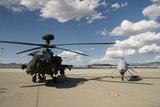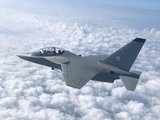I/ITSEC 2022: Red Hawk jet trainer to be digital platform from day one
Trainees will be able to use a VR headset, a dome or a combination of those once the platform is delivered to the USAF. (Photo: Boeing)
Boeing showcased its T-7A Red Hawk pilot simulator and maintenance training system at I/ITSEC 2022 in Orlando, Florida between 28 November and 2 December.
Talking to Shephard at the show, Travis Willis, Boeing international business development, T-7 Red Hawk, said the aircraft's digital twin-based maintenance trainer allows for better, faster and cheaper training.
‘There is a digital twin for every aircraft that gets built that matches the tail number of the platform.’ he said.
Related Articles
Production of Red Hawk is on track after first aircraft rollout, says Boeing
I/ITSEC 2022: BAE Systems and Red 6 augment Hawk trainer jet's reality
This is true both for pilot training – using the same Operational Flight Trainer (OFT) system as the real aircraft – and the maintenance system.
Due to the full digital twin, the maintenance trainer not only allows for practising of repair and similar skills but also enables monitoring of the T-7A's systems, so that maintenance can follow a proactive approach.
The system allows trainees to practice and hone their skills in a fully immersive digital environment, either using VR or AR goggles or through a monitor. T-7A hardware can also be connected to the trainer, such as landing gear, to allow for an even more comprehensive training experience, Willis said.
Boeing said that, in the company’s experience, using digital models like the T-7A maintenance simulator, trainees can experience a 20-40% improvement in learning proficiency, and that will impact costs too.
'A lot of current training systems out there spend up to 40% of their dollars just keeping a training system current.'— Boeing representative.
Willis said that a fully integrated digital training system coupled with hardware could also drive down costs for currency training.
‘A lot of current training systems out there spend up to 40% of their dollars just keeping a training system current. With this one-push capability, we expect that to be much lower on the sustainment cost,’ another Boeing representative told Shephard.
It has not been determined how many maintenance trainers the USAF will receive alongside the T-7A aircraft.
‘What they [USAF] are going to have is a suite of maintenance trainers at Randolph [Air Force Base] with what they call the centralised training facility,’ the representative added.
He said there will be five sites in total with T-7A maintenance training systems. At the other four undergraduate pilot training sites, the representative said, the USAF is going to have a ‘lesser suit of equipment’, which will likely include a lot of VR or AR headsets.
The USAF is currently still working on those sites, with the Request for Proposals (RFP) expected to be released in 2024.
Willis also emphasised that the maintenance training system is not only about software and hardware, but the approach Boeing is taking. It allows for an individual-based learning experience – a method an increasing number of companies and defence bodies take when it comes to training.
‘The customers told me that adaptive learning environment, so the ability for us to do more self-paced learning, is important. So this is how this system is set up so that if your students learn quicker, they can get through those courses much more quickly,’ the Boeing representative added.
Boeing also displayed T-7A flight simulators at I/ITSEC. At the show, the pilot trainer was connected to a Varjo XR-3 Focal Edition, but whether trainees will use VR, a dome or a combination of solutions, is entirely up to the USAF.

T-7A hardware can also be connected to the trainer, such as landing gear, to allow for an even more comprehensive training experience. (Photo: Norbert Neumann)
Willis said that Boeing is already looking into options as to how augmented reality systems could be implemented into the T-7A training system, including while pilots are airborne.
In late September, Boeing and Red 6 inked a partnership deal to see how they could integrate the latter's Airborne Tactical Augmented Reality System (ATARS) into Boeing’s T-7 and F-15EX aircraft.
ATARS would allow pilots to interact with uncrewed aircraft, threats, and targets in real-time, high-speed environments while training in their actual jets.
The USAF is set to receive 46 of the flight simulators.
Boeing could not tell Shephard whether the T-7A trainer is on schedule to be delivered in 2024.
However, it revealed in its Q1 2022 financial results that the programme has experienced financial problems, with a $367 million charge caused by supplier negotiations affected by supply chain problems, COVID-19 issues and inflationary pressures.
At the beginning of November, Boeing also disclosed a loss of $2.8 billion on various defence programmes in the quarter, which included the T-7A Red Hawk.
When asked about the delivery schedule of the Red Hawk by Shephard in May, a Boeing spokesperson insisted the project remains on track.
Whether it arrives on time or not, the T-7A will certainly offer a novel approach to both pilot and ground crew training.
Shephard's I/ITSEC 2022 coverage is sponsored by:

Related Equipment in Defence Insight
More from I/ITSEC 2022 Show Portal
-
![I/ITSEC 2022: HII enhances human-machine teaming training for US Army]()
I/ITSEC 2022: HII enhances human-machine teaming training for US Army
HII’s crewed-uncrewed teaming training system has been tested with the US Army’s Apache, but it can operate with any autonomous system with the right equipment to receive data.
-
![All the news from I/ITSEC and talking seabed warfare]()
All the news from I/ITSEC and talking seabed warfare
The Shephard Media news team looks at all the developments in the military training and simulation world, and discovers the trends and challenges in seabed warfare.
-
![Leonardo explores 6th-generation combat aircraft simulation at I/ITSEC 2022]()
Leonardo explores 6th-generation combat aircraft simulation at I/ITSEC 2022
Leonardo is developing the Smart Chair system in its Battle Lab that allows for advanced pilot training for multi-domain scenarios and can potentially 'replicate a sixth-generation fighter jet cockpit'.
-
![I/ITSEC 2022: Saab stays focused and committed to multi-site training delivery]()
I/ITSEC 2022: Saab stays focused and committed to multi-site training delivery
Saab has increased training activities across core markets, opened combined training centres and is set to grow its business further.
-
![I/ITSEC 2022: CAE to create ‘data ecosystem’ in synthetic environment and rethink approach to innovation]()
I/ITSEC 2022: CAE to create ‘data ecosystem’ in synthetic environment and rethink approach to innovation
CAE believes the future of training technologies will be fundamentally driven by bringing different industries together and no single company can exist in a vacuum - an approach that defence should adopt too.
-
![US Army spotlights constructive synthetic environment re-bids at I/ITSEC 2022]()
US Army spotlights constructive synthetic environment re-bids at I/ITSEC 2022
The US Army's Project Manager Synthetic Environments is overseeing two major re-bid programmes.



























